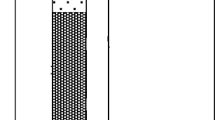Abstract
Little is known about the transport of microorganisms through freeze-fractured clay soils. Normally consolidated clay (NCC) and compacted clay (CC) columns (representing a natural clay barrier and a compacted barrier, respectively) were exposed to six consecutive freeze–thaw cycles and permeated for 21 days with an Escherichia coli cell suspension (approximately 1 × 107 colony forming units (CFU)/mL) containing a 2.1-mM bromide tracer. An unfractured sand column was also examined for comparison with the clay columns. While no E. coli was detected in the effluent of both untreated NCC and CC control clay columns, a relatively low density of E. coli (between 228 and 270 CFU/mL compared to 1 × 107 CFU/mL in the influent) was first detected in the effluent of the freeze-fractured NCC and CC columns at 0.29 and 0.31 pore volumes (or at 5.4 and 4.1 h), respectively. It took 11 min for a full breakthrough of E. coli through the sand column, but only about 0.1% of the influent E. coli density was detected in the effluents of the freeze-fractured NCC and CC columns at day 21. These observations show that despite the high bacterial retention capacity of the freeze-fractured clay columns, the fractures were large enough for the E. coli to flow through. Based on batch sorption tests and the permeation data, it is estimated that 18%, 7%, and 84% of the freeze-fractured NCC, CC, and sand columns would be exposed to the influent, respectively, under a full E. coli breakthrough condition. Our data show that the high bacterial retention capacity of clay barriers can be compromised by freeze–thaw conditions.







Similar content being viewed by others
References
Abu-Ashour, J., Joy, D. M., Lee, H., Whiteley, H. R., & Zelin, S. (1994). Transport of microorganisms through soil. Water Soil and Air Pollution, 75, 141–158.
Amor, K. B., Breeuwer, P., Verbaarschot, P., Rombouts, F. M., Akkermans, A. D., De Vos, W. M., et al. (2002). Multiparametric flow cytometry and cell sorting for the assessment of viable, injured, and dead bifidobacterium cells during bile salt stress. Applied and Environmental Microbiology, 68, 5209–5216.
Andersland, O. B., & Ladanyi, B. (2004). Frozen ground engineering (2nd ed.). Hoboken: Joint publication, American Society of Chemical Engineers and Wiley.
Bardet, J. P. (1997). Experimental soil mechanics. Toronto: Prentice Hall.
Cassidy, M. B., Leung, K. T., Lee, H., & Trevors, J. T. (2000). A comparison of enumeration methods for culturable Pseudomonas fluorescens cells marked with green fluorescent protein. Journal of Microbiological Methods, 40, 135–145.
Celico, C., Varcamoni, M., Guida, M., & Naclerio, G. (2004). Influence of precipitation and soil on transport of fecal Enterococci in fractured limestone aquifers. Applied and Environmental Microbiology, 70, 2843–2847.
Clescerl, L., Greenberg, A., & Eaton, A. D. (1999). Standard methods for examination of water and wastewater (20th ed.). Washington: Joint publication, American Public Health Association (APHA), American Water Works Association (AWWA) and Water Environment Federation (WEF).
Conboy, M. J., & Goss, M. J. (2000). Natural protection of groundwater against bacteria of fecal origin. Journal of Contaminant Hydrology, 43, 1–24.
Eigenbrod, K. D. (1996). Effects of cyclic freezing and thawing on volume changes and permeabilities of soft fine-grained soils. Canadian Geotechnical Journal, 33, 529–537.
Foppen, J., & Schijven, J. (2006). Evaluation of data from the literature on the transport and survival of Escherichia coli and thermotolerant coliforms in aquifers under saturated condition. Water Research, 40, 401–426.
Harvey, R. W., Harms, H., & Landkamer, L. (2007). Transport of microorganisms in the terrestrial subsurface: In situ and laboratory methods. In C. J. Hurst, R. L. Crawford, J. L. Garland, D. A. Lipson, A. L. Mills & L. D. Stetzenback (Eds.), Manual of environmental microbiology (3rd ed., pp. p872–p897). Washington: ASM.
Hillel, D. (1982). Introduction to soil physics. Orlando: Academic.
Jordan, F., Sandrin, S., Frye, R., Brusseau, M., & Maier, R. (2004). The influence of system complexity on bacterial transport in saturated porous media. Journal of Contaminant Hydrology, 74, 19–38.
Lunsdorf, H., Erb, R., Abraham, W., & Timmis, K. (2000). ‘Clay hutches’: A novel interaction between bacteria and clay minerals. Environmental Microbiology, 2, 161–168.
Macler, B., & Merkle, J. (2000). Current knowledge on groundwater microbial pathogens and their control. Journal of Hydrogeology, 8, 29–40.
Marshall, K. C. (1971). Sorptive interactions between soil particles and microorganisms. In A. D. McLaren & J. Skujins (Eds.), Soil biochemistry (Vol. 2, pp. 409–445). New York: Marcel Dekker.
Qian, X., Koerner, R. M., & Gray, D. H. (2002). Geotechnical aspects of landfill design and construction. Toronto: Prentice Hall.
Rowe, R. K., & Booker, J. R. (1991). Modelling of 2D contamination migration in a layered and fractured zone beneath landfills. Canadian Geotechnical Journal, 28, 338–325.
Rowe, R. K., Quigley, R. M., & Booker, J. R. (1995). Clayey barrier systems for waste disposal facilities. London: E & FN Spon.
Taylor, R., Cronin, A., Pedley, S., Barker, J., & Atkinson, T. (2004). The implications of groundwater velocity variations on microbial transport and wellhead protection—Review of field evidence. FEMS Microbiology Ecology, 49, 17–26.
Tresse, O., Errampalli, D., Kostrzynska, M., Leung, K. T., Lee, H., Trevors, J. T., et al. (1998). Green fluorescent protein as a visual marker in a p-nitrophenol degrading Moraxella sp. FEMS Microbiology Letters, 164, 187–193.
Watts, R. (1998). Hazardous wastes: sources, pathways, receptors. Etobicoke, ON: Wiley.
Yee, N., Fein, J., & Daughney, C. (2000). Experimental study of the pH, ionic strength, and reversibility behaviour of bacteria-mineral adsorption. Geochimica et Cosmochimica Acta, 64, 609–617.
Acknowledgments
This research was supported by Natural Science and Engineering Research Council of Canada Discovery Grants granted to K. T. Leung and B. H. Kjartanson. We are thankful for the technical assistance of Dr. K. D. Eigenbrod (Lakehead University) and the undergraduate research students of this project.
Author information
Authors and Affiliations
Corresponding author
Rights and permissions
About this article
Cite this article
Rosa, B.A., Yim, MS., Burdenuk, L. et al. The Transport of Escherichia coli Through Freeze-Fractured Clay Soil. Water Air Soil Pollut 210, 243–254 (2010). https://doi.org/10.1007/s11270-009-0246-y
Received:
Accepted:
Published:
Issue Date:
DOI: https://doi.org/10.1007/s11270-009-0246-y




